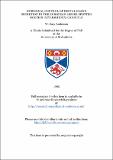Files in this item
Hormonal control of rectal gland secretion in the European lesser spotted dogfish 'Scyliorhinus canicula'
Item metadata
| dc.contributor.advisor | Hazon, N. (Neil) | |
| dc.contributor.author | Anderson, W. Gary | |
| dc.coverage.spatial | 269 p. | en_US |
| dc.date.accessioned | 2018-07-05T14:47:28Z | |
| dc.date.available | 2018-07-05T14:47:28Z | |
| dc.date.issued | 1995 | |
| dc.identifier.uri | https://hdl.handle.net/10023/15007 | |
| dc.description.abstract | 1) Using the corrosion casting technique, which utilises a fast polymerising monomer resin, the vasculature of the rectal gland in Scyliorhinm canicula was studied using light and scanning electron microscopy. Possible control sites for altering blood flow through the rectal gland were identified. 2) A viable and reliable isolated perfused preparation of the rectal gland of S. canicula was developed by optimising flow rate, time of perfusion and viability of individual preparations. The combination of dibutryl cyclic adenosine monophosphate plus the potent phosphodiesterase inhibitor Isobutyl-methyl xanthine, was used as a test of viability for individual preparations. This combination potently stimulated chloride clearance rates from the isolated perfused rectal gland. 3) The isolated perfused preparation was then used to test a variety of hormones that could be involved in the control of rectal gland activity. The hormones, vasoactive intestinal peptide and urotensin II did not stimulate chloride clearance rates from the isolated perfused gland. However, the endogenous natriuretic peptide, C-type natriuretic peptide did stimulate chloride clearance rate from the perfused rectal gland in a dose dependant manner. Endogenous glucagon also stimulated chloride clearance rate. 4) Using cannulated fish, administration of angiotensin II and C-type natriuretic peptide in vivo, produced vasopressor and vasodepressor responses respectively and C-type natriuretic peptide inhibited the vasopressor action of angiotensin II when the two peptides were administered simultaneously. Administration of angiotensin II to the isolated perfused rectal gland produced a vasoconstrictor effect, increasing perfusion pressure. C-type natriuretic peptide did not produce any significant effect. A combination of the two peptides in vitro appeared to reduce the vasoconstrictor effect of angiotensin II. In addition this hormonal combination in vitro appeared to exert a synergistic effect increasing chloride clearance rates from the isolated perfused rectal gland. 5) The lack of a VIP stimulatory effect on the isolated perfused rectal gland in the present study is in agreement with previous reports. Using protein purification techniques including, gel-permeation, and reverse-phase high performance liquid chromatography an endogenous gut peptide was obtained that stimulated rectal gland activity in 5. canicula. This peptide was subsequently characterised as scyliorhinin II and it is proposed that the previously identified rectin and scyliorhinin II are the same peptide. | en_US |
| dc.language.iso | en | en_US |
| dc.publisher | University of St Andrews | |
| dc.subject.lcc | QL638.S34A2 | en |
| dc.subject.lcsh | Squalidae | en |
| dc.title | Hormonal control of rectal gland secretion in the European lesser spotted dogfish 'Scyliorhinus canicula' | en_US |
| dc.type | Thesis | en_US |
| dc.type.qualificationlevel | Doctoral | en_US |
| dc.type.qualificationname | PhD Doctor of Philosophy | en_US |
| dc.publisher.institution | The University of St Andrews | en_US |
This item appears in the following Collection(s)
Items in the St Andrews Research Repository are protected by copyright, with all rights reserved, unless otherwise indicated.

